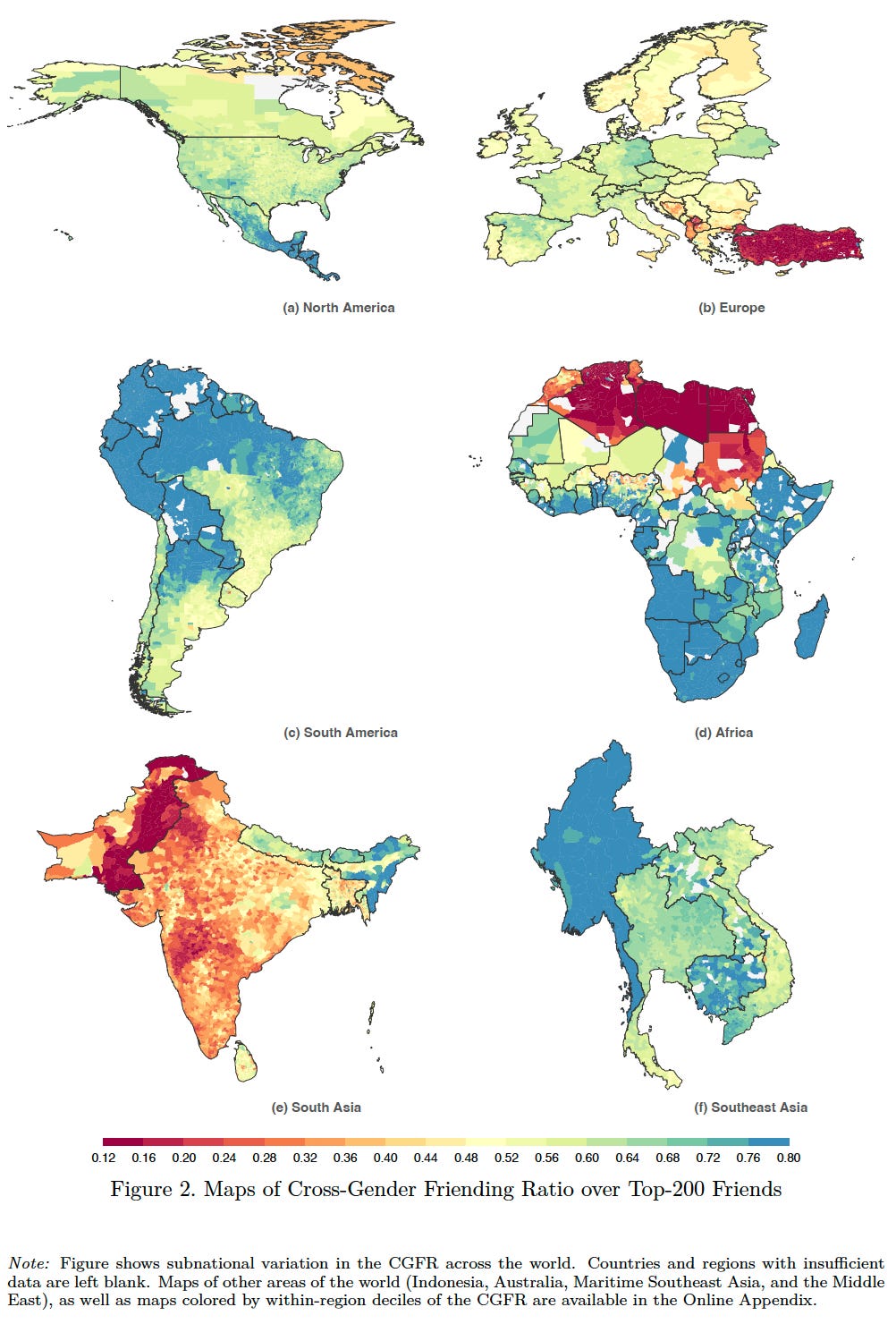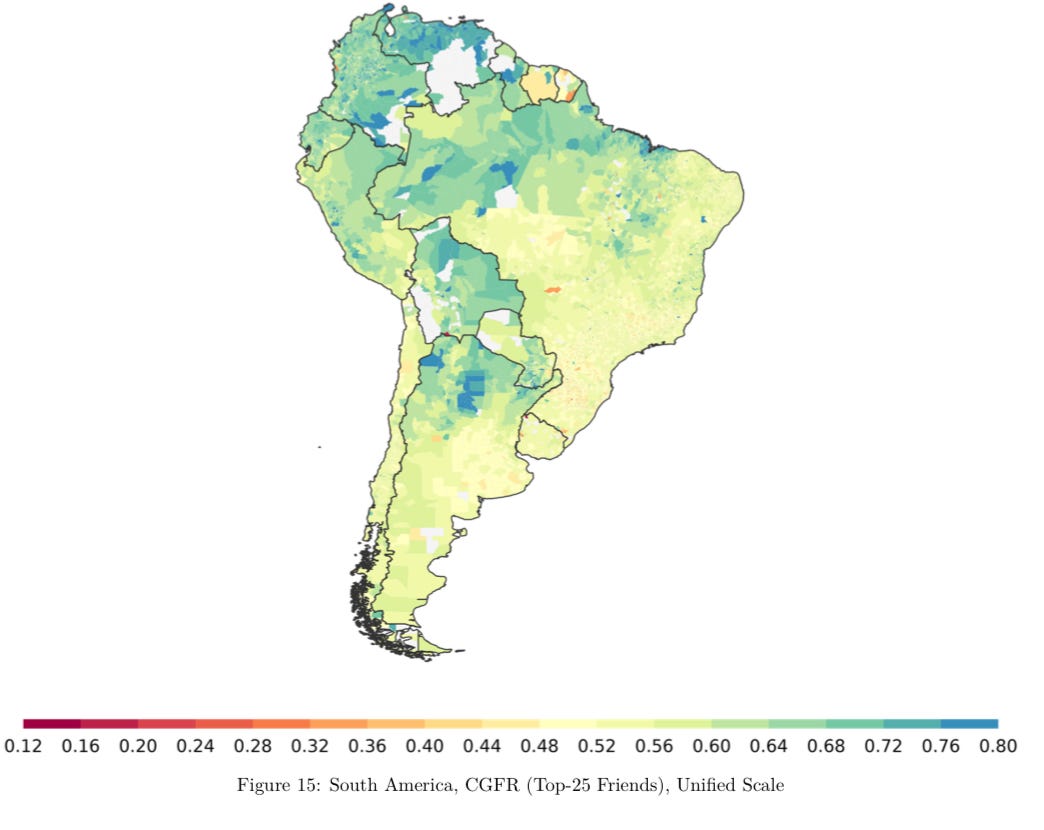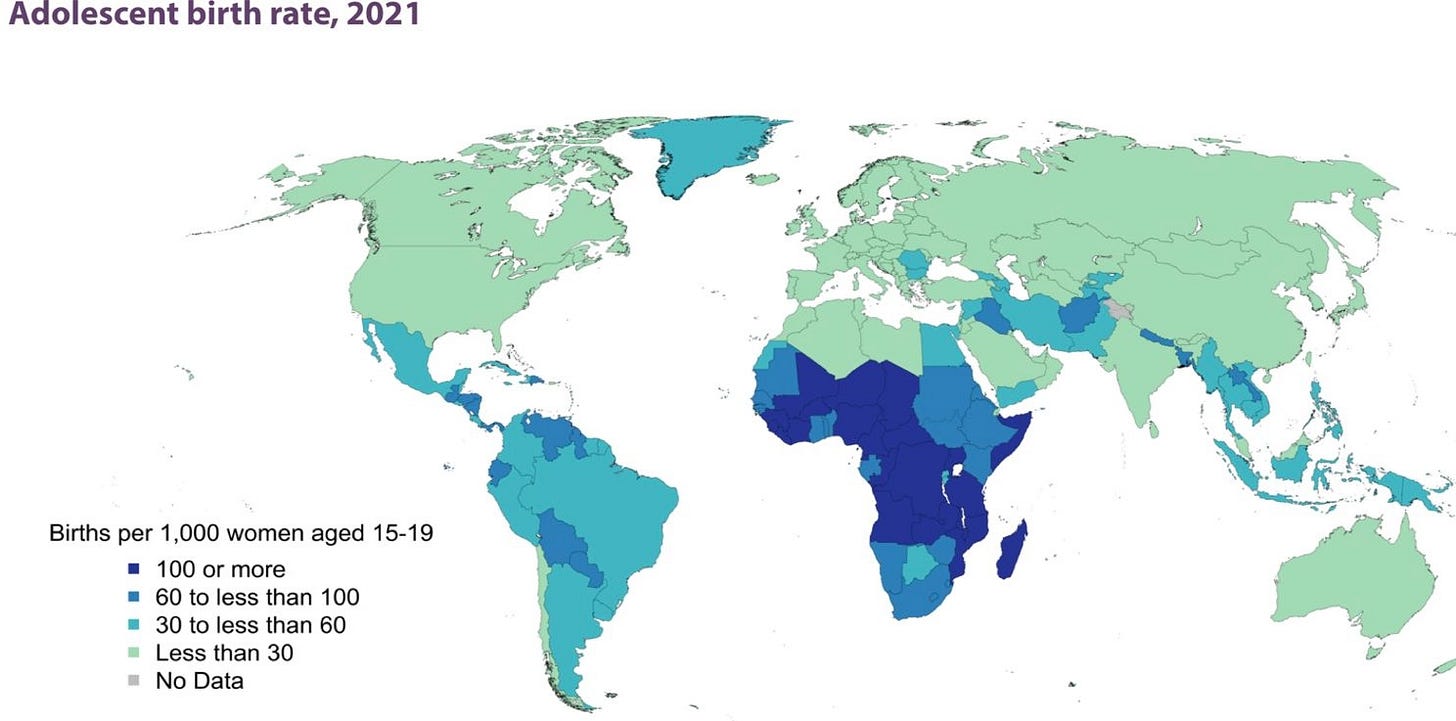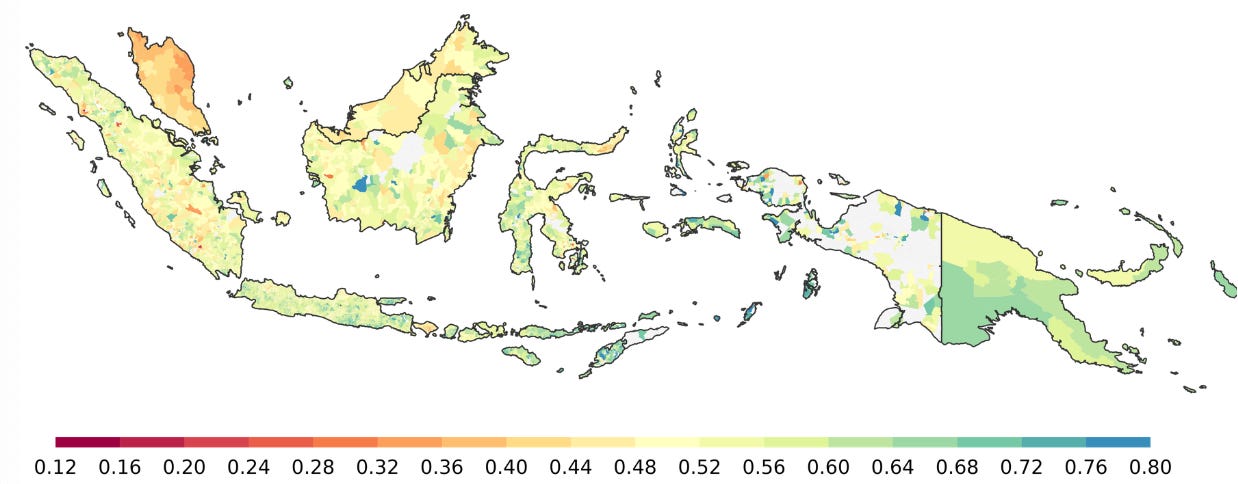Can Men and Women Be Friends? Evidence from 1.3 Trillion Facebook Connections
A phenomenal new paper by Bailey, Johnston, Kuchler, Kumar and Stroebel offers unprecedented insights into gender relations through an extraordinary dataset of 1.38 trillion Facebook connections.
Their analysis of 1.8 billion users reveals a key aspect of my forthcoming book - where men’s honour depends on women’s seclusion, cross-gender friendships are rare, female employment is low, and patriarchy is widely supported.
So let’s dig into this data. Below, I combine this ginormous dataset with my research on global cultural evolution to reveal how Facebook friendships reflect historic state-formation and ongoing cultural struggles. I’ll explore what these patterns tell us about why the world has become more gender equal, and some societies are more gender equal than others.
The Methods Behind the Magic
To understand cross-country variation in cross-gender friendships, Bailey and colleagues focused on Facebook users aged 18-65 who were active in the 30 days before January 9, 2025. To ensure they captured meaningful social connections rather than casual acquaintances, they filtered out users in the bottom 25% of each country's friend count distribution.
At the heart of their analysis lies the Cross-Gender Friending Ratio (CGFR), which first calculates each user's top-n same-country friends who are female (FSⁿᵢ), then computes the share of women in men’s networks divided by the share of women in women’s networks. This effectively controls for both spatial variation in men and women’s typical networks and gender ratios.
Ingeniously, they also calculate variation in friendship strength - ranking each person’s friendships from weakest to strongest. Close social ties (like family members) tend to be the least gender-segregated, while medium-strength ties show marked gender division. This pattern mirrors my qualitative research - for instance, my friend Amal from Karachi knows men within her family, but no further.
Dammit, I am swooning.
Cross-Cultural Heterogeneity
Bailey and colleagues’ first visualisation captures variation in friendship strength in the US, France, Kenya and India.
India’s line lays low - since male Facebook users maintain only 34.5% as many female friendships as women do among their closest 200 connections. Whereas in Kenya, this figure rises to 82.8%. The US and France are more middling, clustering around 0.6.
Lack of Cross-Gender Friendships Predicts Honour Cultures & Low FLFP
These patterns strongly confirm my theory of cross-cultural variation. Across the Middle East, North Africa and South Asia, where male honour depends heavily on female seclusion, women stay close to the home. While some scholars attribute India’s low female employment primarily to too few jobs or too much housework, Facebook data suggests that CULTURE mediates women’s social and economic lives.
In countries where men and women have many friends of the opposite gender, women also work at high rates!! Bam.
Cross-Gender Friendships are correlated with Support for Gender Equality!
Cross-gender friendships are strongly associated with support for gender equality - as I would predict. In cultures where women forge their way in the public sphere, fraternising freely and demonstrating equal competence in socially valued domains, they can forge friendships with men - who crucially come to value their wants and welfare! It’s much harder to build broad support for equality if men don’t have any female friends.
For the data nerds: yes, their analysis incorporates all the usual controls (religion, education, age, marital status, immigration status, gender, and employment status - interacted with country fixed effects). Personally, I don’t think it’s helpful to control for religion, especially when some have strict mandates on gender segregation.
For super precise geographical mapping, they used NUTS3 regions in Europe and GADM2 elsewhere to capture variations within countries, while US analysis drew on additional data from the American Community Survey and US Religious Census.
Global Cultural Variation in Cross-Gender Friendships!
These brilliant heat maps will blow your mind. Using a unified colour scale from deep red (most segregated) to blue (most integrated), they enable direct comparisons across continents. The deep reds in South Asia represent the same degree of gender segregation as deep reds in Africa or the Middle East. The visualisation reveals striking geographical patterns that map historical processes of cultural evolution!!
Omar (from Cairo) told me that his wife doesn’t put her picture as her Facebook avatar, and he doesn’t share any family photos. His concern for honour reflects a regional trend. North Africa, Anatolia and Pakistan glow deep red, showing the lowest rates of cross-gender friendships - which precisely matches historic Islamic rule. In these regions, gender segregation came to symbolise prestige, further reinforced by prevalent cousin marriage practices that encouraged stricter social policing. This pattern extends into Northern Nigeria’s former Islamic caliphates.
While each society has a unique cultural inheritance, there is alway always room for contestation - check out more secular Tunisia and Alevis in Tuncelli.
The Islamic world is seriously diverse. Where Islam spread through trade, it blended with local customs. In The Gambia, where I lived for 9 months, ideals of seclusion are weak, and Muslims have relatively mixed gender friendships.
Importantly, these cultural patterns are not set in stone, but reflect specific historical processes. Modern communications technology has allowed pious believers to learn from the Islamic heartland, Saudi Arabia. Prestige, technology and a tonne of Saudi oil wealth spawned the spread of Wahhabism.
South Asia
Check out the variation between Bangladesh and Pakistan. This perfectly tracks Bangladeshi women’s much higher rates of employment!
North of Bangladesh lie the Khasi hills, with pockets of green - as expected from matriliny.
Let me add one caveat. Gender gaps in mobile internet use are exceptionally large in South Asia. As recently as 2022, only 20% of ever-married Bangladeshi women had ever used the internet. Only the most progressive women would have Facebook friends, so this digital data on cross-gender friendships under-estimates real-life norms of seclusion.
Latin America
What would the data show if Facebook existed in the early 20th century?
Well, in 1922, three male and two female Brazilian modernist artists formed “Grupo dos Cinco” - all close friends!
Sérgio Milliet was not just a close friend but also a great champion of Tarsila do Amaral, organising a major retrospective of her works at the Museo de Arte Moderna in São Paulo, and contributing to a monograph. His support (combined with her clear talent) cemented her reputation. Here’s Tarsila’s portrait of Sergio: a celebration of cross-gender friendship!
Samara da Motta e Silva was born to a working class family, but as a brilliant artist she travelled internationally - even meeting the surrealist Marc Chagall. Permissiveness opens doors, even when women travel!
A century later, it is no surprise that Latin America scores highly on male-female Facebook friendships. Of course, these are not necessarily platonic.
Southeast Asia
Islam arrived through maritime trade routes, blending with existing traditions of bilateral kinship, Hindu-Buddhist influences, and women’s active participation in public life. The result? Female labor force participation near global averages and notably higher rates of cross-gender friendship.
Check out the sub-regional diversity! In Peninsula Malaysia, where there is a strong conservative religious movement, championing Malay-Muslim identity, there are far fewer cross-gender friendships!
The second map below shows Malaysia’s election results for 2022. As you can see, Perikatan Nasional (coloured in teal) won in places where men and women are seldom friends (orange)!!
Subnational Diversity!
49% of the global cross-regional variation is within country!!! Compared to East Germans, West German men have fewer female friends! So too in the Muslim-majority northern parts of the Gulf of Guinea and Mozambique, people typically have fewer friends of the opposite sex.
Over in the US, Black Americans are more likely to have cross-gender friends, as shown below.
Key Lessons:
Bailey and colleagues’ global analysis reveals that cross-gender friendships remain rare in societies where male honour depends on female seclusion. This culture predicts both low female labor force participation and more patriarchal beliefs. By using actual data on friendships, rather than self-reported survey data, they make a hugely important contribution.
Honestly, I could not have imagined a better proof of my theory! Thank you!
Let me add, male friends are no magic bullet for gender equality! This merely reflects a permissive culture. Congolese women move independently, but are still at serious risk of abuse.
Structural transformation and democratisation are vital! Skill-biased technological change enabled women to control their fertility and demonstrate equal competence in socially valued domains, while sustained organising and media independence enabled feminist critique and attitudinal change. State capacity is equally crucial - to abate male violence.
Does Culture Change with Migration?
In a previous paper, Bailey, Johnston, Koenen, Kuchler, Russel and Stroebel use Facebook data to track social integration. Rather than tracking ties between genders, they examine migrants’ friendships with German natives.
Over time, Syrian men integrate but women do not.
Again, this reflects honour culture and ultra low female employment. Among Germany’s Syrian and other refugees, only 20% of women have found employment.
BRAVO!
This paper is so absolutely brilliant. To paraphrase Sir Mix-a-lot, I love BIG Data. Massive congratulations to Bailey, Johnston, Kuchler, Kumar and Stroebel, who have made their data publicly available through the Humanitarian Data Exchange.
If others dig deeper, please let me know!!
And on Valentine’s Day, let me add, that to find true love, you also need the freedom to explore diverse friendships.💞💖💓💘



















So I'm sitting here in Sweden wondering how in the world you missed the chance to point out the delicious irony that Sweden (and Scandinavia generally) is coming off as very sexist here, and much more so than the "macho" cultures of Africa and Latin America! Sweden and Finland are basically the same as Poland. More on this, please, because it is very counter-intuitive.
Also, can we remark upon the East and West divide in Germany? The former GDR seems to have totally bucked the trend in the former USSR. Or how the more European Mercosur region of Latin America is less gender equal on this metric.
Fascinating findings that would really challenge a lot of country's self-concept!
Interesting as always. Thanks for sharing! Tiny correction: the Turkish province is called Tunceli, not Tuncelli :)